
Kohlrabi, also called German turnip or turnip cabbage, is a biennial vegetable, a low, stout cultivar of wild cabbage. It is a cultivar of the same species as cabbage, broccoli, cauliflower, kale, Brussels sprouts, collard greens, Savoy cabbage, and gai lan.

The turnip or white turnip is a root vegetable commonly grown in temperate climates worldwide for its white, fleshy taproot. Small, tender varieties are grown for human consumption, while larger varieties are grown as feed for livestock. Turnip is also used in Northern England, Scotland, Ireland, Cornwall, Devon, and parts of Canada, to refer to what in the USA is called rutabaga, also known as neep or swede, a larger, yellow root vegetable in the same genus (Brassica).

Cabbage, comprising several cultivars of Brassica oleracea, is a leafy green, red (purple), or white biennial plant grown as an annual vegetable crop for its dense-leaved heads. It is descended from the wild cabbage, and belongs to the "cole crops" or brassicas, meaning it is closely related to broccoli and cauliflower ; Brussels sprouts ; and Savoy cabbage.
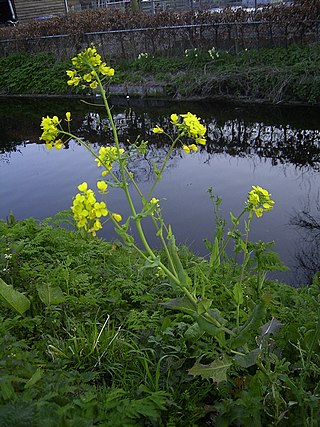
Brassica is a genus of plants in the cabbage and mustard family (Brassicaceae). The members of the genus are informally known as cruciferous vegetables, cabbages, mustard plants, or simply brassicas. Crops from this genus are sometimes called cole crops—derived from the Latin caulis, denoting the stem or stalk of a plant.
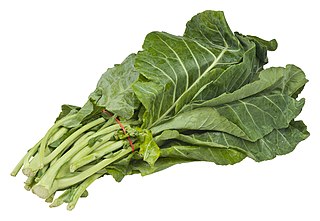
Collard is a group of loose-leafed cultivars of Brassica oleracea, the same species as many common vegetables including cabbage and broccoli. Part of the Acephala (kale) cultivar group, it is also classified as the variety B. oleracea var. viridis.

Kale, also called leaf cabbage, belongs to a group of cabbage cultivars primarily grown for their edible leaves. It has also been used as an ornamental plant.

Rapini or broccoli rabe is a green cruciferous vegetable, with the leaves, buds, and stems all being edible; the buds somewhat resemble broccoli, but do not form a large head. Rapini is known for its bitter taste, and is particularly associated with Mediterranean cuisine.
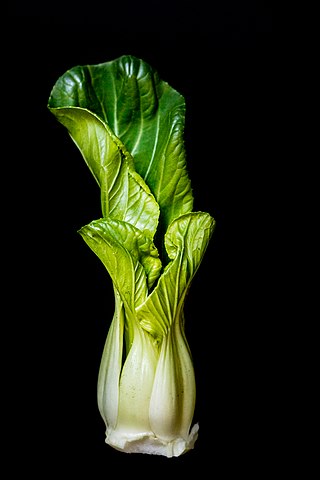
Bok choy, pak choi or pok choi is a type of Chinese cabbage, used as food. Chinensis varieties do not form heads and have green leaf blades with lighter bulbous bottoms instead, forming a cluster reminiscent of mustard greens. It has a flavor between spinach and water chestnuts but is slightly sweeter, with a mildly peppery undertone. The green leaves have a stronger flavor than the white bulb.

Gai lan, kai-lan, Chinese broccoli, or Chinese kale is a leafy vegetable with thick, flat, glossy blue-green leaves with thick stems, and florets similar to broccoli. A Brassica oleracea cultivar, gai lan is in the group alboglabra. When gone to flower, its white blossoms resemble that of its cousin Matthiola incana or hoary stock. The flavor is very similar to that of broccoli, but noticeably stronger and slightly more bitter.

Choy sum is a leafy vegetable commonly used in Chinese cuisine. It is a member of the genus Brassica of the mustard family, Brassicaceae. Choy sum is a transliteration of the Cantonese name, which can be literally translated as "heart of the vegetable". Choy sum is also called yu choy. It is also known as Chinese flowering cabbage.

Brassica oleracea is a plant species from family Brassicaceae that includes many common cultivars used as vegetables, such as cabbage, broccoli, cauliflower, kale, Brussels sprouts, collard greens, Savoy cabbage, kohlrabi, and gai lan.

Leaf vegetables, also called leafy greens, pot herbs, vegetable greens, or simply greens, are plant leaves eaten as a vegetable, sometimes accompanied by tender petioles and shoots. Leaf vegetables eaten raw in a salad can be called salad greens.

Brassica rapa is a plant species growing in various widely cultivated forms including the turnip ; Komatsuna, napa cabbage, bomdong, bok choy, and rapini.

Brassica juncea, commonly brown mustard, Chinese mustard, Indian mustard, leaf mustard, Oriental mustard and vegetable mustard, is a species of mustard plant.

Savoy cabbage is a variety of the plant species Brassica oleracea. Savoy cabbage is a winter vegetable and one of several cabbage varieties. It has crinkled, emerald green leaves, which are crunchy with a slightly elastic consistency on the palate.
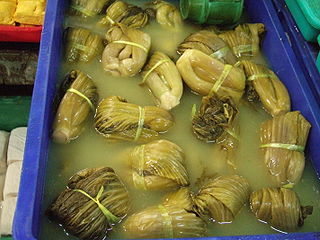
Suancai is a traditional Chinese pickled Chinese cabbage or Chinese mustard, used for a variety of purposes. Suancai is a unique form of paocai, due to the ingredients used and the method of production.
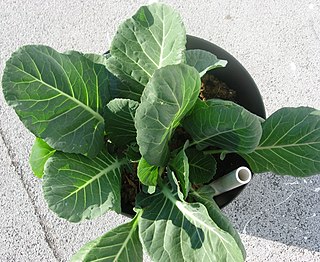
The acephala group refers to any type of Brassica which grows without the central 'head' typical of many varieties of cabbage. These are included within the species Brassica oleracea, such as kale. The name literally means "without a head" in contrast to those varieties known as capitata or "with a head". This group includes a number of species, both wild and cultivated, many of which are grown for their edible leaves and flowers.

Tatsoi is an Asian variety of Brassica rapa grown for greens. Also called tat choy, it is closely related to the more familiar bok choy. This plant has become popular in North American cuisine as well, and is now grown throughout the world.

Napa cabbage is a type of Chinese cabbage originating near the Beijing region of China that is widely used in East Asian cuisine. Since the 20th century, it has also become a widespread crop in Europe, the Americas and Australia. In much of the world, it is referred to as "Chinese cabbage". In Australia it is sometimes referred to as "wombok".



















